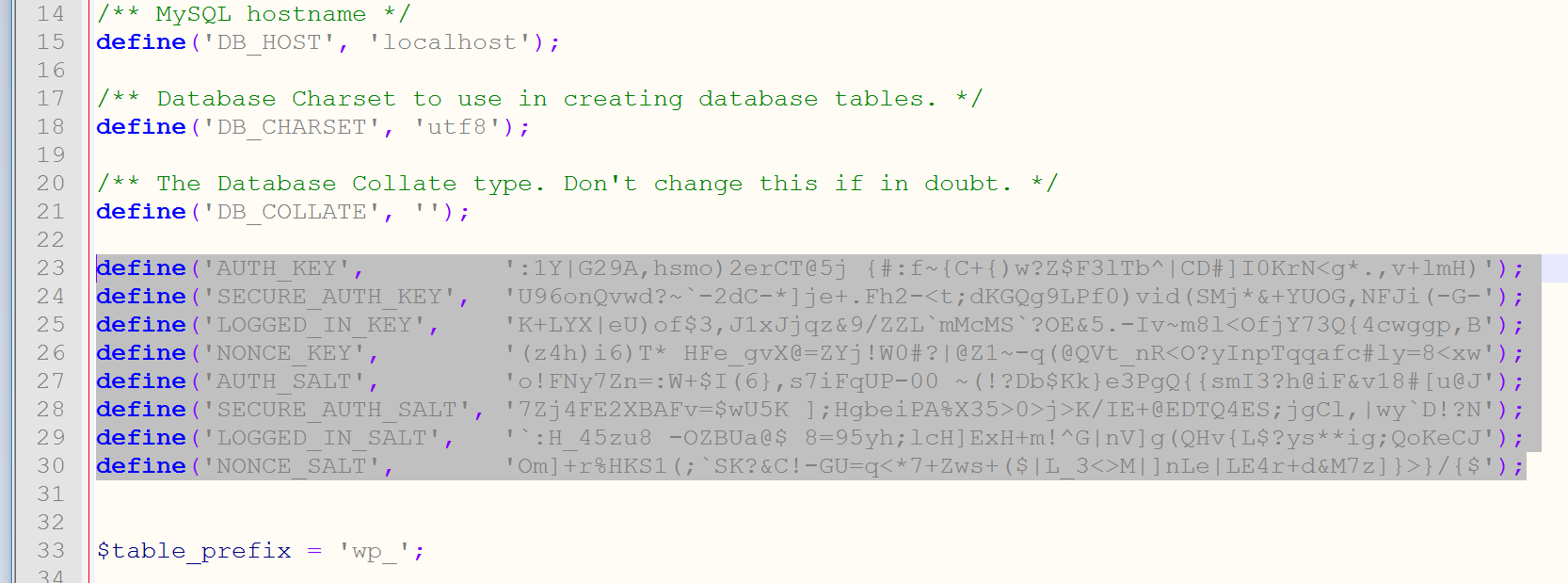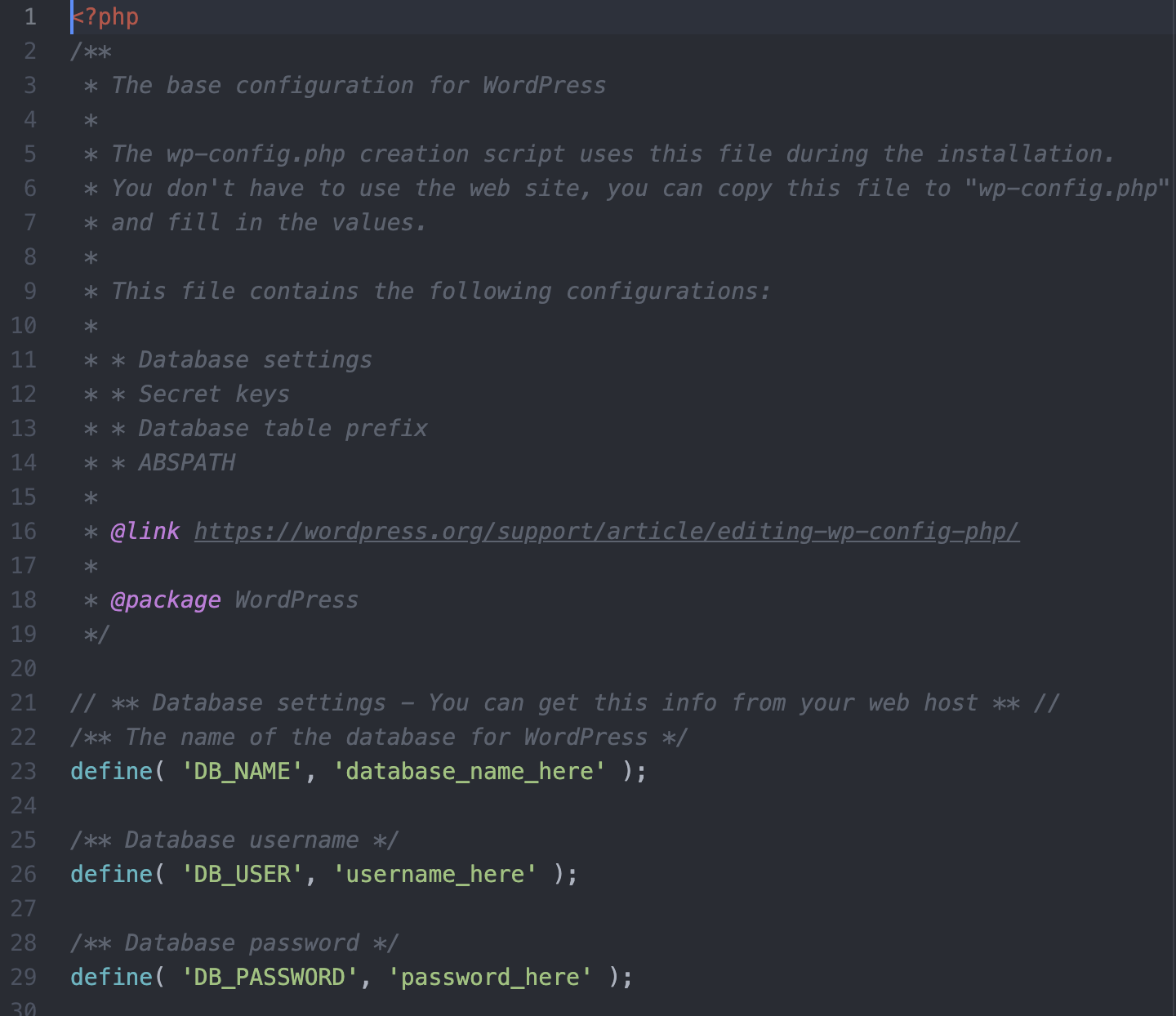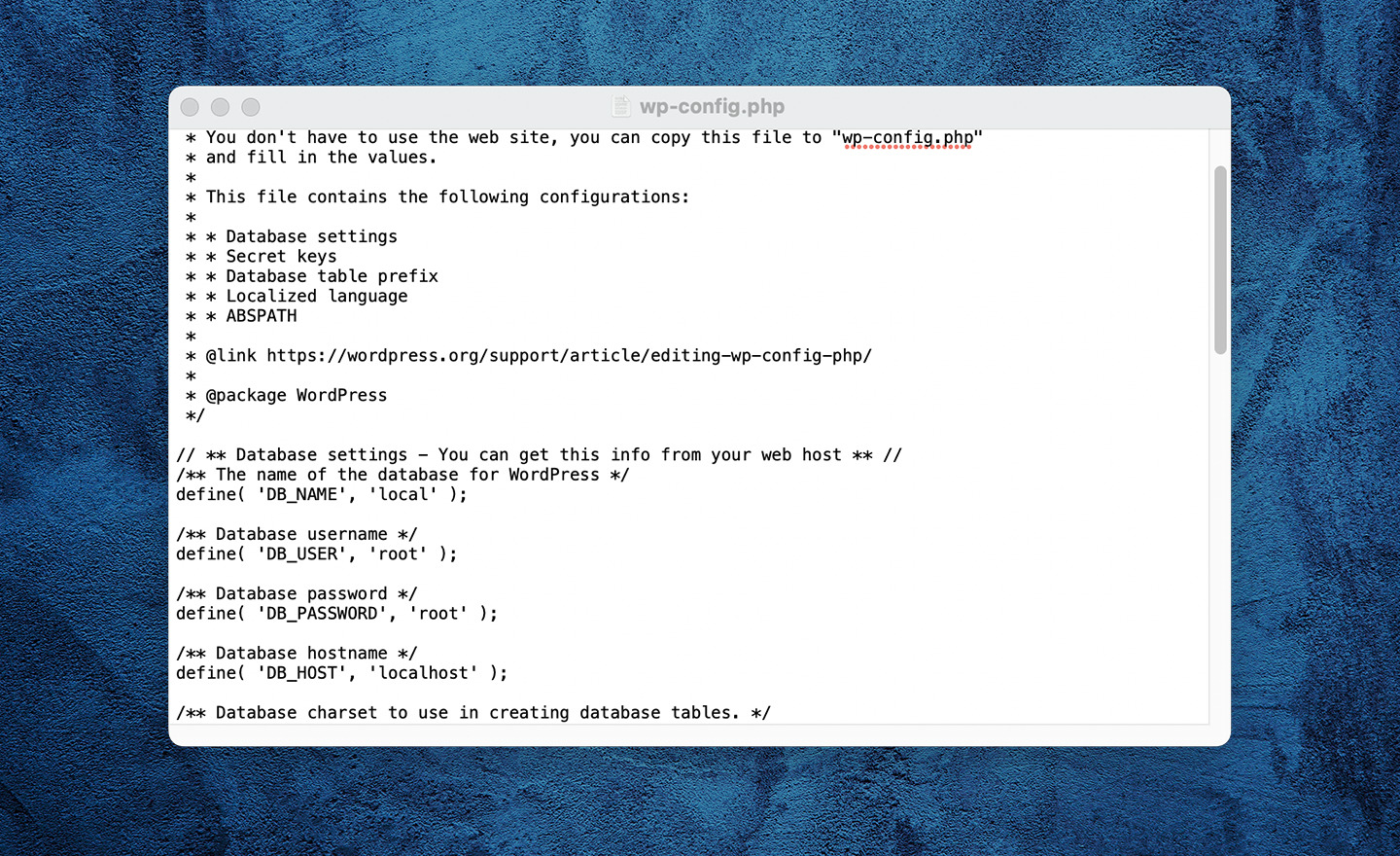Wp Config.php~


Wp Config.php~: Protecting and Optimizing Your WordPress Site from the Core
In the sprawling universe of website creation and management, WordPress stands as a household name, empowering millions of users ranging from novice bloggers to seasoned web developers. The secret to WordPress’s unprecedented success lies in its powerful yet user-friendly configuration system, with one file being central to it all: wp-config.php. Yet, for many, this file, along with its sometimes pesky companion wp-config.php~, remains an enigmatic presence, shrouded in mystery and filled with uncharted potential.
You may wonder why understanding a single configuration file is worth your time in the bustling digital age, where trends shift as swiftly as the clouds. However, if you’re serious about securing, optimizing, and customizing your WordPress site, then wp-config.php is more than just a file; it’s the key to unlocking advanced functionalities and ensuring your website’s resilience against cyber threats. But wait, where does wp-config.php~ fit into this puzzle?
The file named wp-config.php~ might seem like a mere afterthought, a shadowy twin to its more famous counterpart, easily discarded as unimportant. In reality, understanding the implications and handling of this file can be critical for your site’s security and performance. This introduction isn’t just about a file; it’s about navigating the nuances of WordPress’s configuration architecture in a meaningful way.
In our digital theater, where WordPress takes center stage, wp-config.php acts as the script controlling the actions behind the scenes. Many times, the file wp-config.php~ represents an unsaved backup or an interim version inadvertently left exposed, thus necessitating caution and deliberate attention from developers and site owners alike.
Our exploration will guide you through the paramount considerations: from unraveling the oft-overlooked risks associated with inadvertently leaving wp-config.php~ accessible to scrutinizing the cardinals of customization in wp-config.php itself. We will delve into the intricate processes that govern how this file orchestrates the symphony of your database connections, enhances site performance, safeguards security façades, and ultimately, allows an unprecedented level of customization.
Imagine your WordPress site as a complex musical composition. The wp-config.php file is akin to the sheet music that dictates every note, every crescendo, enabling harmony across the site’s numerous components. How this metaphorical sheet music is handled—whether it drifts carelessly into the hands of those uninvited through the form of wp-config.php~, or remains a well-guarded piece of profound potential—is what this blog post aims to assist with.
Throughout this guide, we will pull back the curtain on some intricately intertwined challenges, broaden your understanding of configuration file management, and equip you with practical insights to manipulate this powerful tool to your advantage. We’ll start by identifying common pitfalls related to wp-config.php~, such as its stealthy accommodation within web directories and potential exposure, before weaving through the essential directives that make wp-config.php the steadfast backbone of your website.
Look forward to sectioning aside obstacles of misconception, perhaps learning about how environment variables can be abstractly employed to bypass certain static inputs, ensuring each reader walks away with a toolkit capable of bolstering both site security and performance. This content promises a deep dive beyond surface-level advice, aiming to leave lasting impressions about responsible and effective WordPress site management.
Whether you are a fledgling developer eager to build from the foundations up, a meticulous webmaster longing to fortify an already established empire, or simply a curious individual intrigued by the inner workings of web technology—the comprehensive breakdown that follows isn’t just beneficial; it’s essential. Embark on a journey where understanding translates to empowerment, and unlock the true potential of your WordPress site by mastering what lurks behind the veneer of wp-config.php.
Ready yourself for an exploration into something as ubiquitous as it is profound; because in the world of WordPress, knowledge is power and wp-config.php is knowledge made manifest.
Get ready to delve into the secrets and opportunities encased within WordPress’ most pivotal component in our following sections titled: “Mastering WP Config.php: Security, Performance, and Customization” .

What is wp-config.php?
The wp-config.php file is a crucial component of your WordPress installation. It’s located in the root directory of your WordPress files and serves several vital roles. Primarily, it is responsible for configuring the fundamental settings of your WordPress site, including the database connection details and several important configurations that ensure smooth operation.
Enhancing Security with wp-config.php
1. Securing Database Credentials
The wp-config.php file contains sensitive data such as your database name, database username, password, and host. Ensure these values are correct and secure to prevent unauthorized access. Consider the following enhancements for added security:
- Move
wp-config.phpto a higher level directory, one level up from your web root, so it is inaccessible from the web. - Use secure usernames and strong passwords for your database connection.
2. Defining Security Keys and Salts
WordPress uses a set of security keys and salts to encrypt session and cookie data to ensure data integrity. In the wp-config.php file, you’ll find the following lines:
define('AUTH_KEY', 'put your unique phrase here');
define('SECURE_AUTH_KEY', 'put your unique phrase here');
define('LOGGED_IN_KEY', 'put your unique phrase here');
define('NONCE_KEY', 'put your unique phrase here');
define('AUTH_SALT', 'put your unique phrase here');
define('SECURE_AUTH_SALT', 'put your unique phrase here');
define('LOGGED_IN_SALT', 'put your unique phrase here');
define('NONCE_SALT', 'put your unique phrase here');
To enhance security, update these key phrases. You can generate new ones from the WordPress Secret Key Generator.
Optimizing Performance with wp-config.php
1. Enable Caching
To improve the performance of your WordPress site, enable caching by adding the following lines to your wp-config.php file:
define('WP_CACHE', true);
This setting works alongside caching plugins like WP Super Cache or W3 Total Cache, allowing them to serve cached HTML versions of your pages to visitors, reducing server load and improving page load times.
2. Disable Post Revisions
By default, WordPress automatically saves and creates revisions every time you update a post. While useful, excessive revisions can lead to a bloated database. To limit or disable revisions, include the following line:
define('WP_POST_REVISIONS', false); // Or set a limit, e.g., 5
3. Increasing Memory Limits
If you encounter memory limit errors on your site, you can increase the PHP memory limit for WordPress by adjusting the following line:
define('WP_MEMORY_LIMIT', '256M');
Depending on your hosting environment, you may need to contact your host to increase the memory limit beyond what’s specified here.
Customization Opportunities with wp-config.php
1. Debugging and Logging Errors
Enable WordPress debugging mode to help you troubleshoot issues. This can be achieved with the following lines:
define('WP_DEBUG', true);
define('WP_DEBUG_LOG', true);
define('WP_DEBUG_DISPLAY', false);
By setting WP_DEBUG_DISPLAY to false, errors are logged to a file instead of being shown to users, maintaining a more professional appearance for end-users. You can later access the debug log in wp-content/debug.log.
2. Customizing Autosave Intervals
The autosave feature in WordPress is set to save your changes every 60 seconds. This might be shorter or longer than you need and can be modified as follows:
define('AUTOSAVE_INTERVAL', 300); // 300 seconds or 5 minutes
3. Changing the Table Prefix
By default, WordPress uses the table prefix wp_. Changing this prefix during installation is a good security measure to protect against SQL injection attacks. However, you can update it by altering this line:
$table_prefix = 'wp_secure_';
Be cautious if changing this on an already established website, as it can break your site’s database connection.
Advanced Options and Tweaks
1. Custom File and Directory Permissions
To prevent unauthorized file changes, you can define custom file and directory permissions using:
define('FS_CHMOD_FILE', 0644);
define('FS_CHMOD_DIR', 0755);
2. Disabling Plugin and Theme Editing
To prevent code alteration directly from the WordPress dashboard, which can be risky, you can disable theme and plugin editing by adding:
define('DISALLOW_FILE_EDIT', true);
3. Ensuring HTTPS with SSL
Force all logins and admin sessions to be secure by using the following SSL settings:
define('FORCE_SSL_LOGIN', true);
define('FORCE_SSL_ADMIN', true);
It ensures all data sent to your site is encrypted, adding an extra layer of security.
Conclusion
Mastering Your Wp-Config.php File
In the journey of managing and optimizing your WordPress site, understanding and properly configuring your wp-config.php file is crucial. This seemingly simple file holds the keys to control a plethora of functionalities that can safeguard and streamline your WordPress environment. Let’s revisit some of the essential practices that have been discussed, ensuring it’s fresh in your mind as you tackle this vital component of your website infrastructure.
Key Practices Recap
Security Enhancements: At the outset, we delved into foundational security practices. The wp-config.php file is paramount in fortifying a WordPress site. Protecting it involves securing file permissions and moving it above your web root directory – a recommended maneuver to thwart unauthorized access. Ensuring that it remains immune to remote access through careful configuration changes is fundamental in keeping malicious users at bay.
Database Connection Secrets: Another critical aspect is configuring your database connection. By securely setting database credentials within wp-config.php, you operate at the core of WordPress’s data management system. This section emphasized the significance of changing the database table prefix from the default wp_ for additional security against SQL injection attacks, a prevalent threat on the guardrails of your digital empire.
Authentication Keys and Salts: Effective secret key management shapes a substantial part of wp-config.php’s powers. Utilizing WordPress.org’s secret-key service to generate unique authentication keys and salts is imperative for all site administrators. This strategy not only enhances the security chain of your site but also contributes to the integrity and validity of user sessions.
Debugging Facilities: In the main content, we expanded on the importance of enabling debugging features during development. By activating WP_DEBUG, WP_DEBUG_LOG, and WP_DEBUG_DISPLAY, developers can gain meaningful insights into run-time operations, hence facilitating robust and error-resistant web development. Remember, toggle these off when shifting to a production environment to maintain an efficient front-end interface.
Site Configuration Controls: Fine-tuning site-specific configurations like post revisions and autosave intervals can considerably influence site performance. By limiting post revisions with WP_POST_REVISIONS and modifying autosave frequencies, you wield control over the resource demands and server load, thus enhancing end-user experiences.
Performance Optimization: Beyond debugging, wp-config.php provides manipulation levers to enhance performance. We emphasized leveraging memory allocation through WP_MEMORY_LIMIT for demanding applications, ensuring your site performs optimally during peak traffic periods.
Your Next Steps
At the heart of this discussion is the power and flexibility that the wp-config.php file offers. It serves as a cornerstone, providing endless possibilities to customize and secure your WordPress installation. With the right adjustments and configurations, your site can accomplish greater heights in security, performance, and reliability.
Now that you have absorbed these essential practices, it’s time to translate this knowledge into action. Here’s what you can do to continue engaging with this topic:
- Implement Changes: Open your wp-config.php file and start applying some of the ideas we’ve explored. Whether it involves improving security standards, enhancing performance, or preparing for better debugging, the practice will reinforce the topic’s relevance.
- Routine Checks and Updates: Commit to periodically reviewing your wp-config.php file, especially after updates or significant changes to your site. Consistent oversight ensures your configurations remain aligned with best practices and the evolving landscape of WordPress security.
- Deepen Your Knowledge: Stay informed about new configurations and best practices by following WordPress community forums, developer blogs, and security news. Understanding evolving trends will encourage proactive adaptations and refined strategies for your site’s benefit.
- Share Your Experience: Join WordPress communities or forums and share your insights and experiences with wp-config.php. Engaging with others not only reinforces learning but also positions you as a knowledgeable resource within the community, promoting collaborative growth and security awareness.
Continuing the Conversation
We invite you to continue the conversation about wp-config.php practices. Share your thoughts, ask questions, and provide feedback on the configurations that have most positively impacted your WordPress site. Participate in forums, comment sections, and online discussions where WordPress enthusiasts and experts convene.
To further ignite your engagement, consider documenting your journey with wp-config.php in a blog post or tutorial. This practice not only solidifies your understanding but also enriches the WordPress user community with shared experiences and discoveries.
In closing, remember that the power of WordPress lies not just in its vast capabilities, but in the vigilant stewardship of its components, like wp-config.php. Embrace the opportunity to fine-tune and protect your WordPress site, turning potential vulnerabilities into fortified advantages. The reliability and performance of your website are reflections of the thoughtful configurations and considerations you implement.
Ultimately, as you leverage the expertise and guidance shared today, you’re not just managing a website—you’re cultivating an environment that embodies security, efficiency, and innovation. With the wp-config.php file now demystified and tamed, you hold the reins to steer your WordPress experience toward new horizons.
Start engaging with the WordPress community today!












 News
News Review
Review Startup
Startup Strategy
Strategy Technology
Technology
